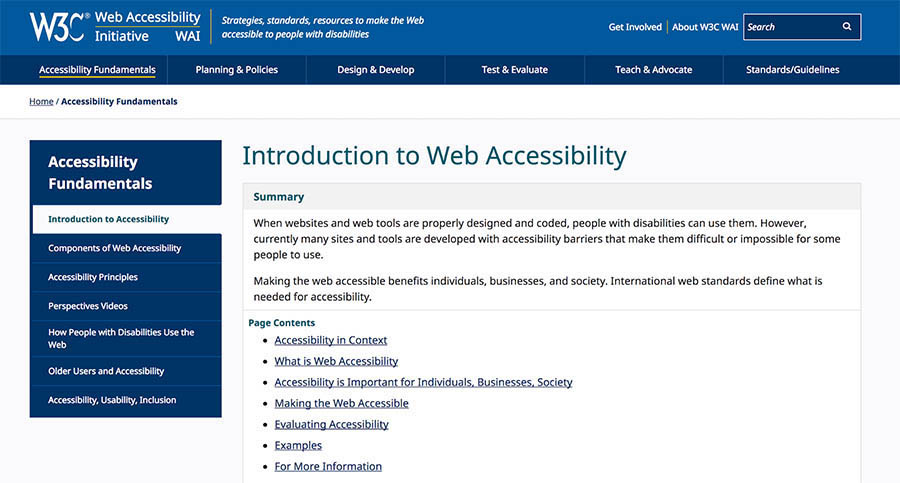Does my website need to have ADA and WCAG Accessibility Compliance?
When it comes to ADA compliance (Americans with Disabilities Act), most people assume that it relates to physical accommodations. For example, if you have a local business, you should have wheelchair access.
However, ADA compliance goes beyond physical accommodations. It extends to the online world as well which means that if you have a website for your business, it needs to be accessible.
But what even is ADA compliance and why is it important? What does it involve? Those are the questions we’ll answer in this post.
What is ADA compliance?
Put simply, ADA compliance means that your website follows the rules and guidelines from the 2010 Americans with Disabilities Act Standards for Accessible Design.
These guidelines and standards mandate that both Internet users with disabilities as well as those without disabilities must be able to access and use all electronic and information technology.
It’s important to mention that when the Americans with Disabilities Act first came to be, it didn’t include the term websites as a form of “Public Accommodation”. However, in the recent years, many courts have included websites and apps into the definition of Public Accommodation.
Who Needs Accessibility?
There are several groups of people who need your website to be accessible:
- Blind or Deaf/Blind People — According to WHO, globally, 2.2 billion people have a near or distance vision impairment. Deaf persons might suffer from hearing loss in one or both ears. Settings like magnification and brightness as well as offering transcriptions and captions will make your website more accessible.
- Persons with cognition and learning difficulties — This group includes both children and adults. Having a simple page layout and doing away with animation and video or audio files that play automatically are helpful in these cases.
- Persons with emotional and behavioral disabilities — Make your website more accessible by simplifying page layouts, shortening your sentences, and incorporating white space into your design.
- Persons with permanent or temporary injuries and diseases — Users who have permanent or temporary injuries or suffer from a disease that impacts their ability to use the Internet rely on assistive technologies. Having audible software and keyboard tab navigation is one way of making sure they can access and use your website.
- Persons traveling — accessibility goes beyond your place of residence. People who travel need accessible hotel bookings, doctor’s appointments when they’re traveling, food delivery services, and many other services. Those services are easier to use when they’ve been designed with accessibility in mind.
Why is Accessibility Important?
Statistics show that 54% of all disabled adults in the US use the internet on a daily basis. If your website is ADA compliant, this ensures that they can access and use it in the same way as people without disabilities would.
Another reason why accessibility matters is that you could face a lawsuit as well as a substantial fine. In fact, lots of lawsuits are happening right now. One example is a lawsuit in Colorado where a blind man is suing the local winery because they couldn’t use their website since it wasn’t compatible with screen-reading programs.
Something similar happened in 2016 where a blind man sued Domino’s Pizza because they couldn’t order pizza from their website.
Is My Website ADA Compliant?
If you have to ask if your website is ADA compliant, chances are it’s not. There’s a lot to consider when it comes to making your website accessible. This brings us to the next point which we will discuss below.
What Does Website ADA Compliance Involve?
Now that we’ve covered what is ADA compliance and why accessibility is important, let’s take a look at what’s involved in making sure your website is ADA compliant.
Start With Accessibility Audit
The first thing you should do is access your current website and perform an accessibility audit. This will tell you where your compliance issues are and you can then take appropriate measures to address them. The cost for this usually runs in the 4-figures range.
You can also use tools like WAVE and AXE. Both of these tools are free and can be used as a starting point for your accessibility audit.
In general, you’ll want to pay attention to these main areas of accessibility as outlined in the WCAG 2.1 Guidelines:
- Use of color
- Links
- Screen Reader Reminders
- Content Structure & Semantics
- Images & Media
- Documents (like PDFs)
Accessibility Remediation
Once you know where your accessibility issues are, you can begin resolving them on your site. This can be a combination of things that can be done automatically (for example, installing an image optimization plugin to automatically ads captions and alt text for images or disabling autoplay on audio and video files) and things that need to be taken care of manually (such as implementing a responsive design, adding skip links or switching to a platform that has basic accessibility guidelines in place).
On-Going Accessibility Maintenance
The last step is to implement an on-going accessibility maintenance for your website. Websites are always changing and you need to make sure that newly added content follows the accessibility guidelines. Otherwise, your hard work on making sure your website is accessible won’t matter much.
What’s Next?
The ADA compliance will make your website accessible to all Internet users. While it does require a bit of work upfront, it also keeps you out of legal trouble. If you need help updating your website to be more ADA compliant or want to design a new website with accessibility in mind, contact us.
Share this post
We focus on beautiful web design that delivers results for your organization. Our specialty is creating customized WordPress websites.
About Us
Johnny Flash Productions
Johnny Flash Productions is a creative agency based outside of Washington D.C. that focuses on digital strategy, web design and development, graphic design and event production that helps businesses get better results from their marketing.
I cannot begin to speak highly enough of Johnny Flash Productions. I was first alerted to their company by doing a Google search & found only one company around with so many 5-star reviews, so was curious if they could all be real. I found through working with John & Eowyn & the Johnny Flash team that we were able to collaborate to create the perfect website for our organization.

Working with John and his team has been such a wonderful experience! They consistently go above and beyond to quickly complete our requests, and it's great working with a team of true experts.
I highly recommend them for anyone looking for WordPress developers.

We regularly get rave reviews about our website. Often other non-profits have asked us for a referral. Johnny Flash was easy to work with and has always been responsive to our needs. They provided several built in tools that help keep our website from becoming stale.

I recommend Johnny Flash Productions because they respond promptly and with honesty when requesting their services, they are very professional and I am a satisfied client!
They fulfilled my expectations with the website and branding project. It has already been a success and helped us reach our goals for our business. Thanks Johnny Flash Productions.

Johnny Flash redesigned both our church website and our preschool website to align with our new branding, helped us switch web hosts and met some tight timelines as well. John and his team are always professional, have fresh ideas and are quick to respond to questions.
They also worked us to revamp both websites within our set budget while still providing a quality web design and custom look. If I could give them ten stars, I would!

We chose Johnny Flash Productions because I knew the person, John Falke. Relationships are important. Knowing character is important and relevant to business decisions. Knowing whether a person/business will stick by their word is important along with can they perform.
A company that can perform is good, but if they do not stick by their word, skill means nothing. You produced a great product, worked with us, gave a fair price and kept us on task.

We found Johnny Flash Productions to be professional and a pleasure to work with. Their industry knowledge and creative approaches were incredibly helpful.
Our new website exceeds our expectations and we look forward to continuing our relationship with Johnny Flash Productions with their responsive and ongoing website upkeep, maintenance and SEO.

We had a great experience working with Joli and the team at Johnny Flash. Their whole process was very helpful to shaping and sharing our website message.

John and his team at Johnny Flash Productions did an amazing job on our new company website! John was very patient and professional throughout the entire process and always responsive to any request we had.
I would definitely recommend their services to anyone looking to create a website!

We are truly grateful for our time working with John and his team. They were able to manage a full redesign within a relatively tight timeline and delivered an impressive site that also worked well through mobile devices as well.
They kept us on schedule as well and were a pleasure to work with. The team continues to be incredibly responsive following the initial launch.

I was looking for a web designer who was not only talented, but could deliver - and keep delivering what I needed month after month. The team at Johnny Flash Productions brought ideas to the table that complemented what I wanted to do with my website and their design exceeded my expectations.
I was willing to pay more for their continuing monthly service than I had paid previously because they laid out what I could expect from their team. So far, they have under promised and over delivered.

This process was so much easier than I expected. John listened carefully to what I was expecting to accomplish with our website and kept me focused on our objectives.
We are now able to register preschool students online (especially important during COVID). Parents are very happy that now they have the option to pay by credit card. I would highly recommend this company!

Excellent WordPress Web Designer, we are so lucky to have them design our website we were very satisfied with the results!

Such an amazing service. A beautiful website that has already gotten the practice new business. John kept us on track so that our website was up and running in the time allotted. Thanks so much. Highly recommend.

Johnny Flash Productions helped breathe new life into Immanuel’s online presence with their wonderful redesign of our website. Aside from their consummate professionalism, flexibility and keen attention to detail, they were an absolute pleasure to work with.
It had to be a daunting task to be presented with the enormous number of expectations , hopes and ideas generated from our church’s website committee throughout the course of the website re-design, but if anything, Johnny Flash's resulting work exceeded all expectations.
I’m sure I can speak for all of us on the committee when saying that we’d heartily recommend Johnny Flash to any church or organization in need of a skilled, knowledgeable, easy-to-work with design company.

It has been such a pleasure working with John and Nicole to develop our WordPress website. The team is very professional and worked closely with us during the entire process. We couldn't be happier with the result, we love our new website.
I definitely recommend Johnny Flash Productions!

They did excellent design work, were professional and responsive. They were an absolute pleasure to work with, and I plan on using them for future projects.

We have a fabulous website thanks to their excellent process.

Johnny Flash did a great job on our new Wellesley Hills Congregational Church website. Delivered on time and on budget. They helped us shape good content as well.
We were so satisfied we had them redo our Wellesley Nursery School in the Hills website also.

John and his team are great to work with. We have worked with them on a broad range of projects including logo development, campaign materials and website design. They are a great partner!

Efficient, effective and professional - Johnny Flash Productions did an awesome job of rebranding and migrating our WordPress website. We launched last week and there is positive feedback all around for the sleek, new, mobile friendly look.

The Johnny Flash team is incredibly skilled, attentive and patient. We are very happy with our new WordPress website!

Our organization couldn't be happier with the beautiful website Johnny Flash Productions created for us. They helped streamline thousands of components from our previous site into a site that portrays the mission of our organization and tells the story of our purpose while bringing in and engaging new and returning visitors.
We wouldn't hesitate to use them again and have already recommended them to several people who have seen the quality of our new site.
We have also seen a remarkable uptick in response in those who have gone to the site just in the first few weeks since launch in signing up for future communications. That is the sort of prolonged engagement we have been looking for, and Johnny Flash Productions delivered beyond our hopes.

Professional, knowledgeable, friendly! Everything you could ask for in a website development firm/SEO company. Johnny Flash Productions is the best website development firm and SEO firm in Northern Virginia!

John has been managing my website SEO and Google Ads for only a few months now and his services have already generated profitable leads. I can’t say enough about his company’s professionalism, promptness and results oriented approach. Hiring his company has been an excellent business decision!!

John Falke and Johnny Flash were incredible to work with and produced a very professional and progressive website for Covenant Park Consulting and were completely responsive to our vision and goals.

I have worked with Johnny Flash Productions on 3 of my own websites and recommended Johnny Flash productions to two other family members who were also in need of new websites. We have all had an exceptional experience during the process.
The staff are very responsive, organized, on time and they follow through until the work is complete. We valued them so much that we use them for our monthly maintenance and they help with our advertising online.

John, Joli and Team provided the path forward for us on how to take our desire to have a brand new website to getting it launched and live. We started at a high level of who we were and what we wanted to accomplish with our website.
John provided an up front schedule of what tasks would be completed by when from their team.
There were tweaks along the way that we would make and feedback given, and it was always well received with the changes being made in a timely manner. Thanks John and Joli.

We have been very pleased with our website design experience with Johnny Flash. We appreciated how their structured process enabled our website team to prioritize our goals for the project and develop a final product customized to meet our individual needs.

Johnny Flash Productions and their team were aces to work with. Their process was simple, and project schedule was on target.
More importantly, their Storybrand mindset opened us up to a whole new world for our website presence, business development and even our own client communication.

Johnny Flash and team approached the project with as much passion as we had (we're a very passionate team) for the site and logo refresh. We worked through the logo and website designs and within a couple of weeks, it felt as if we were all one company.
The team was super responsive, understood our vision for the logo/website and communicated clearly every step of the way.

I must admit that I was not crazy about revamping our website, primarily due to the time commitment and cost. However, in looking through the updated content this morning, the new website looks terrific and was well worth the time and expense.
Thanks to you and your team for all of your hard work.

Johnny Flash Productions is a company that truly cares about their clients, this is obvious by not only their work ethic but they also the way they put their heart into every project they complete.
Johnny Flash Productions was a pleasure to work with, we look forward to working with them again in the future.

I would like to thank Johnny Flash Productions for there great service my company has been able to get to get to the top of Google searches in half the time most companies take. I am now receiving 3 to 5 viable leads a day that all lead to service work for my company. And I can not thank them enough for all of there support with my site and maintaining it for me.

John and his team do top quality design work, website work, and just about anything you would need to have a dynamic presentation in both print and digital media. Incredibly talented and innovative, you can call him with a "thought" that comes back to you better than you ever imagined. Truly professional and talented, I could not recommend more highly.

Exceeded all expectations in their abilities to professionally evaluate and customize our company WordPress website. Above all else, their customer service is the best I've dealt with in a long time with any company I've worked with in the past. I definitely recommend Johnny Flash Productions to anyone looking for exceptional service, professional detail and customer support.

Was a pleasure to work with Johnny Flash Productions to walk through the full life cycle of a complete redesign of several of our ministries websites. Working with people who are experts caused us to think outside the box in how we really tell our story through our website.
The entire team was great to work with and the value has been incredible! God is good!

Johnny Flash Productions gets results building stand-out websites that are optimized for success! Their team of professionals worked quickly to get to know my business and developed a plan of action. Their designers developed an amazing design that exceeded our expectations. If your organization or business is looking to build or improve your presence online.
I highly recommend Johnny Flash Productions!

We used Johnny Flash Productions to help us recreate our website and to make it more visually appealing and more current. Working with them was very pleasant and easy. They really listened to what we were looking for and worked within that framework.
I would highly recommend them. I am happy to provide a reference or answer any questions that you may have.

Johnny Flash Productions was a joy to work with! They helped our church completely re-do our website. They also helped us refresh our look and logo. We have had many people comment on how much they love our new website and how much easier it is to navigate.

When we all get a little too busy, sometimes we forget to say a heartfelt "Thank You"! I am so grateful that God led us to partner with you. I know good things will come from our hard work done together in His name. The website is terrific. Pure and simple.
Thanks for your expertise, guidance and always friendly attitude.

Johnny Flash Productions has played an integral role in the growth of our business. From logo redesigns, website design and management, fliers, banners, signs and more, they have done an incredible job of taking our ideas and WOWing us with his visual designs.
John's knowledge base allows them to understand our ideas and concepts and bring it all together in a professional, well thought out deliverable. Their work has always exceeded our expectations in both quality and speed.
We look forward to continuing our long business relationship as he continues to stay on top and ahead of visual marketing trends without losing it’s classic appeal.








